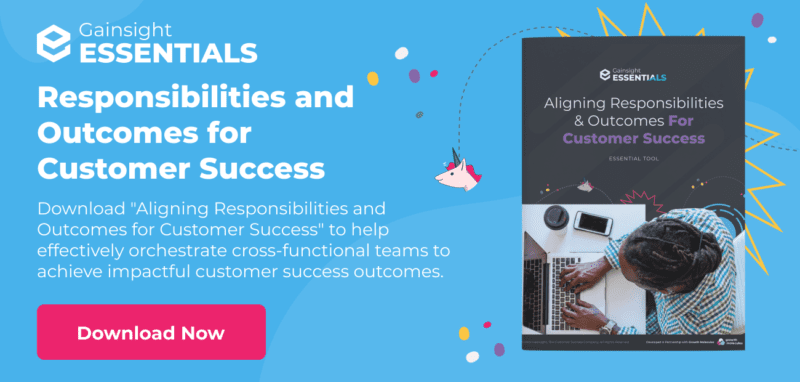By Sabina Pons, Operating Partner at Growth Molecules™ and a 2022 Top 100 CS Strategist.
In Customer Success circles, we practice the belief that when a company has the customer at the center of all that it does, customer outcomes will be achieved.
This means that the product or service that a company is providing satisfies customers’ business needs. The greatest likelihood of delivering this value for customers is rooted in the foundational philosophy of customer-centricity across all departments within an organization.
However, ensuring cross-functional alignment can be difficult to achieve. In fact, according to new research by the Chief Marketing Officer (CMO) Council, only 14 percent of marketers say that customer-centricity is a hallmark of their companies, and only 11 percent believe their customers would agree with that characterization. Keep reading to learn three key tips to help get your internal departments working together to successfully serve your customers.
Make the Mission Known
I once had a manager tell me “inspect what you expect.” That means that if something matters, it needs to be top of mind. Similarly, if delivering a remarkable customer experience is truly the company’s goal, as it should be in a recurring revenue SaaS business, then the leadership team should talk about this mission regularly. Furthermore, the mission should be the North Star for all company goals such that any project, initiative, or even internal meeting, should clearly tie back to the customer-centric mission.
Many companies communicate across their organization effectively to ensure that every department understands the primary objectives. One that comes to mind is SpaceX. Although aerospace is different from business-to-business (B2B) SaaS, SpaceX did provide a fascinating experience that left a lasting impression.
When visiting their Hawthorne, California headquarters in 2016, it was a member of the SpaceX accounting team that recited the statistics and led the turn-by-turn facility tour. Rather than having dedicated operations or community relations employees provide the rundown of the inner workings for visitors, SpaceX prefers to have employees rotate this responsibility. This strategy ensures that the mission, both figuratively and literally, is well understood by all of Elon Musk’s employees. The same can be done for building a customer-centric culture in B2B SaaS: if customer outcomes are regularly revisited internally, employees can help realize those outcomes for customers externally.
Teach Employees How to Help
Providing employees with an understanding of the mission is crucial, and so is enabling them with the necessary skills to help. According to studies cited by the Social and Behavioral Change Communication, self-efficacy as a personal cognitive factor means that “individuals are more likely to practice a desired behavior if they perceive that they have the necessary skills and capacity to do so.” Oftentimes people want to help but lack the understanding of how to help. Give them what they need, show them the way, and then get out of their way.
When nurturing employee skill development, grand enablement gestures are welcomed but are not required. After all, not all companies have reached a post-unicorn status and may lack the budget for a dedicated customer success enablement team. Fiscally friendly alternatives may include hosting “lunch and learn” sessions where the Chief Customer Officer, or VP / Director of Customer Success share customer stories and key examples of true customer success.
Another option is to have a buddy program where employees from different departments share their current ongoings: what they’ve recently accomplished, what they’re working on now, and what’s up next. Facilitating opportunities for cross-communication fosters a sense of belonging and idea-sharing. Another byproduct of this partnering can be accountability for upholding the company’s mission. When creative solutions are applied, enabling employees can be economical and can come with a high impact.
Clearly Set Expectations (RACI)
When a company has cross-functional alignment on the mission, and employees have the tools and understanding of the job(s) to be done, there is a greater likelihood that customer-centricity will be part of the company’s DNA. The most critical factor, however, is clearly setting expectations so your employees are certain about his/her role within the organization. For every project, initiative, and deliverable, be sure to designate and communicate ownership so that roles and responsibilities are clear. Some questions that should be top of mind for a customer-centric company include:
- Who owns the customer onboarding?
- Who delivers customer training?
- Who handles customer contract renewals?
- Who is responsible for reporting customer retention?
- Who drives customer loyalty initiatives like VOC programs?
A tool called a “RACI Model” is helpful to determine the answers to these questions. This framework also helps companies avoid confusion, prevent potential redundancies, and lays a solid foundation upon which deliverables can be realized. RACI is an acronym for:
- R = Responsible: The person that is responsible for the task at hand
- A = Accountable:
- C = Consulted:
- I = Informed
RACI models are often used by project managers to clearly articulate roles and responsibilities at a project’s onset. They also help leaders to set a solid foundation for how a company’s departments align efforts to provide a stellar customer experience. In fact, it’s the RACI model that the Gainsight team uses internally to operationalize their customer outcomes too!
Many companies in start-up, scale-up, and growth-stage levels of revenue maturity tend to prioritize product development and sales acquisition plays. However, the true underpinning of customer-centricity must come from a company culture that truly centers its strategy around the customer experience.
The experience comes from how the customer experiences value and therefore value realization should be the guiding principle for all strategic company goals in a healthy B2B SaaS business. Defining the what (“What are we aiming to achieve?”), the how (“How will we make it happen and what tools are needed to do so?”), and the who (“Who will make it happen?”) are key components of successful delivery of the company goals, especially when seeking company-wide alignment around supporting customers.


